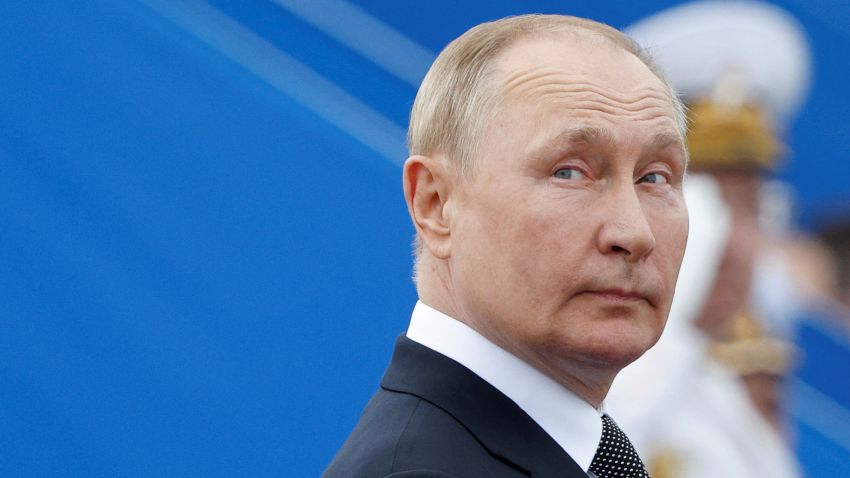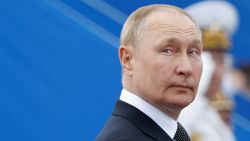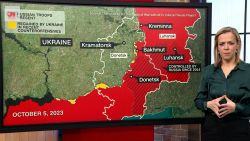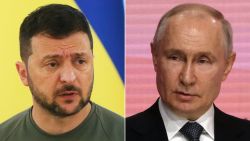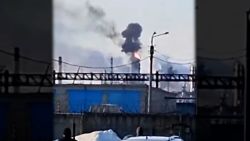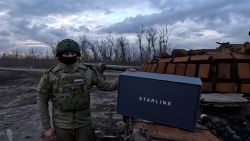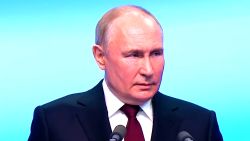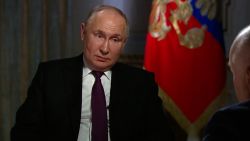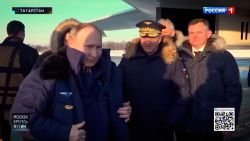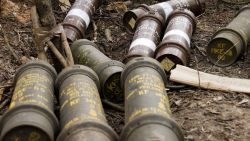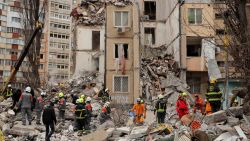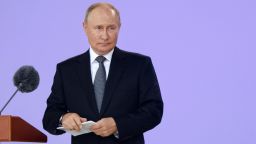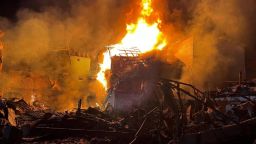Editor’s Note: David A. Andelman, a contributor to CNN, twice winner of the Deadline Club Award, is a chevalier of the French Legion of Honor, author of “A Red Line in the Sand: Diplomacy, Strategy, and the History of Wars That Might Still Happen” and blogs at Andelman Unleashed. He formerly was a correspondent for The New York Times and CBS News in Europe and Asia. The views expressed in this commentary are his own. View more opinion at CNN.
In the end it may all come down to who runs out of ammunition – and soldiers – first. Not to mention the will to win.
Even after the apparently stunning progress of Ukrainian forces in the east of their country – including the seizure of the strategic city of Izyum and the pullback of Russian forces – it is still clear, as Ukrainian Defense Minister Oleksiy Reznikov observed, that Ukraine is far from claiming any decisive triumph.

Enormous quantities of ammunition – and number of personnel – are still being expended on both sides in this effort by Ukraine for relatively small territorial advances, out of the vast territories Russia seized in the east and south in the earlier days of the conflict.
It’s not clear in the euphoria of Ukraine’s advances last week that the United States or the West fully appreciates the depth of the commitment that may be necessary if Russia’s ambitions are to be thwarted and the territory it has seized reclaimed.
“What is apparent in Ukraine – on both sides – is not just an ability to continue to resist, but an astonishing ability to persist,” said David E. Johnson, a principal researcher at the Rand Corp. and an adjunct scholar at the Modern War Institute at West Point. “In what has become a grinding war of attrition with high numbers of casualties on both sides, neither combatant appears ready to throw in the towel.”
Indeed, the BBC observed in a caveat Sunday, “Russians still hold around a fifth of the country and few imagine a swift end to the war.” Also on Sunday, Reznikov told the Financial Times, “A counter-offensive liberates territory and after that you have to control it and be ready to defend it. Of course, we have to be worried, this war has worried us for years.”
In July, even before the current Ukrainian offensive was launched, a senior American military official reportedly said the Russians had expended quite a lot of their smart munitions. At the same time, advanced High Mobility Artillery Rocket Systems, or HIMARS, supplied by the US were enabling Ukraine to take out more than 100 strategic targets – ranging from Russian command posts to air-defense sites, radar and communications nodes, long-range artillery positions and ammunitions depots.
Between June, when the first HIMARS began deployment, and July, Reznikov said the rocket systems had been used to destroy 50 Russian ammunition depots.
Since then, Ukraine’s pace of attacks and Western resupply efforts have grown only more intense. “Vladimir Putin seems to believe that Russia can win the long game, outlasting the Ukrainians in their will to fight and the international community’s will to continue to support Ukraine,” Colin Kahl, US undersecretary of defense for policy, said at a recent press briefing, adding that the latest Ukraine security assistance packages are “a tangible demonstration that this is yet another Russian miscalculation.”
Without question, Putin is now beginning to face some of the challenges that have been quite clear to Western leaders until now, with even more complications. Though he clearly controls the media and dissemination of information on the war, more social media are beginning to break through, and anti-war voices are being heard.
They are on the cusp of becoming as strident as some Western voices, especially in Europe where sanctions designed to thwart Russian efforts are beginning to bite even before a long cold winter without supplies of natural gas and oil that Putin is turning off in reprisal.
The winner will be the side that is best able to withstand these drumbeats of negativism.
Ukrainian President Volodymyr Zelensky said the military had recaptured more than 30 settlements in the region of Kharkiv near the frontier with Russia. And Ukraine officials exulted in the recapture of the strategic rail hub of Izyum in the east on Sunday. The authoritative Institute for the Study of War reported, “Ukrainian forces are likely clearing pockets of disorganized Russian forces caught in the rapid Ukrainian advance to Kupyansk, Izyum, and the Oskil River.”
But so far, these have been simply pockets. Maps of currently held or even contested territory show Russia still holding vast chunks of territory in Ukraine’s east and south – though at growing costs.
The problems facing Russia are not simply the depletion of military stockpiles ranging from smart bombs and cruise missiles to basic ammunition.
The Pentagon reported two weeks ago that Russia was “desperately trying to fill its ranks depleted by its poor showing” in the Ukraine theater.
A senior Pentagon official said Russia had begun “in part eliminating the upper age limits for new recruits and also by recruiting prisoners. Many of these new recruits have been observed as older, unfit and ill-trained.”
Still, there is substantial evidence that Russia is fighting a war in which it has shown extraordinary capacities, especially for endurance – one unlike anything the United States or its allies has fought since World War II.
“My sense is that they realize this is going to be a long war, and they’re preparing for the next year,” Johnson of Rand told me in a telephone interview. “It’s been so long since the West has been engaged in a war of this sort that we just forgot how horrendous it is. Quite frankly, I’m stunned by the casualties, that they’re both able to sustain.”
(Reliable casualty figures are difficult, with both sides limiting media access to battlefields and statistics.)
Indeed, Russia seems to be planning for a war that could last years rather than months. “The center of gravity in this war is Western support for the Ukrainians,” Johnson observed. “If they don’t have that, it’s over.”
This is the reason Russia is seeking alternate sources of supply, especially artillery shells for the 152 mm Soviet-era howitzers that are still the staple of the Russian land army and widely used across Ukraine.
So, Putin has reached out to North Korea’s Kim Jong Un in an exchange of letters last month. Russia is now in the process of purchasing millions of rockets and artillery shells from North Korea for use on the battlefield in Ukraine, according to a US official.
And later this week Putin will meet Chinese President Xi Jinping, who still pulls many strings in Pyongyang, at a summit in Uzbekistan.
“North Korea is more than happy to trade gas and oil for projectiles,” Johnson told me. Equally, the Kremlin has reportedly lined up large quantities of battlefield drones from Iran – the Mohajer-6 and Shahed series – under potential long-term contracts.
Other industrial materials that no longer can be sourced from the West due to sanctions are being sourced from other producers, notably Turkey or illicitly from Western European producers via Turkish middlemen. “What they (Russia) cannot buy from Germany, Italy and France, they are buying from us,” said Cetin Tecdelioglu, head of the Istanbul Ferrous and Non-Ferrous Metals Exporters’ Association, as quoted by Reuters. “Separately, a lot of EU companies are planning to sell their products to Russia via Turkey.”
Russia’s institutional stamina is also a prime reason the United States and the West should continue to supply Ukraine as long as possible. “There is the ‘Arsenal of Democracy’ theory of give them (Ukraine) everything they need because every Russian tank you kill now, you won’t have to kill later,” Johnson observed, evoking a phrase coined by President Franklin D. Roosevelt during a fireside chat in 1940 just before the US entered World War II but was already supplying Allied forces against Hitler’s Nazis.
Get our free weekly newsletter
One critical step in this direction is likely to be a September 28 meeting of national armaments directors from the Ukraine Defense Contact Group of 50 nations committed to supplying that nation’s war needs. High on the meeting’s agenda, according to Bill LaPlante, US undersecretary of defense for acquisition and sustainment, will be mobilizing “the global defense industrial base (to) continue to support Ukraine both now and into the future.”
With Russia scrambling desperately to replace much of this supply chain it can no longer source from the West, and with a potentially very long war ahead, stamina and persistence should be America’s highest priorities.

